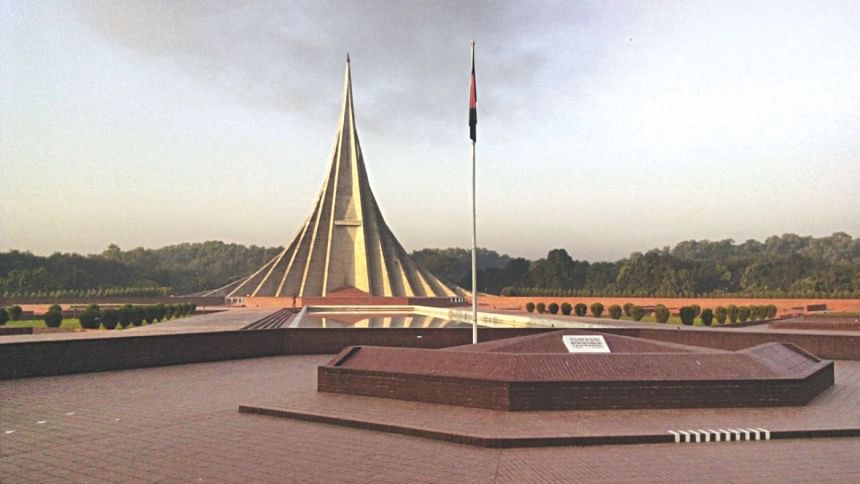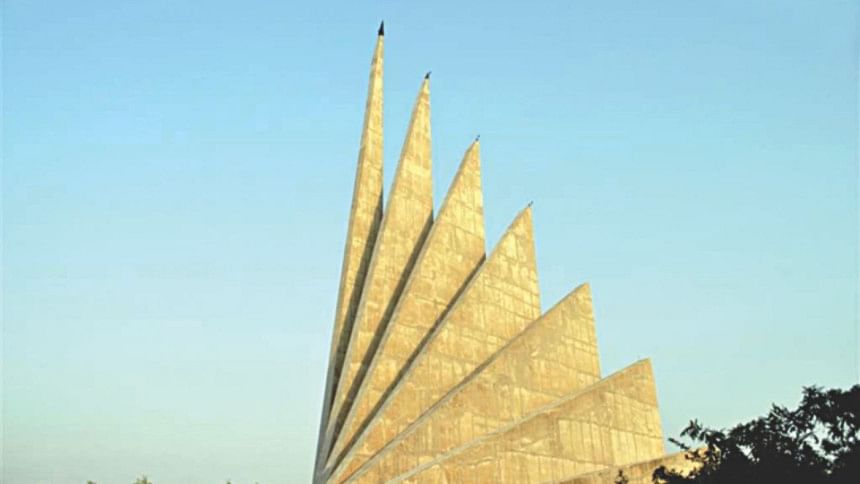The rising spirit

Some would say that the seven towers at the Savar National Monument of Bangladesh represent the seven 'Bir-sreshtho' and others would argue that no, they speak on behalf of the seven major revolutionary events (the language movement of 1952 followed by the mass upheavals of 1954, 1958, 1962, 1966, 1969 and finally the Liberation War of 1971), leading gradually to independence and victory of this country. How you interpret is up to you though, as the monument belongs to everyone in the country.
At 35 kilometers north-west of Dhaka city, you will find yourself at this memorial, created in order to pay tribute to the valiant martyrs of our Liberation War.The blueprint of this concrete monument was done by Syed Mainul Hossain. Interestingly, he was not directly assigned as the architect for the project, rather won the privilege by winning the design competition held by the government in 1978, out of 56 other contestants.
The government had inaugurated the foundation (by the hands of Bangabandhu Sheikh Mujibur Rahman himself) much earlier, within a few months of the nation's victory, in 1972, which involved acquiring land for the site and the construction of roads for communication, requiring a budget of the then astounding amount of Tk.26 lacs.
The second part of the project took place in between 1974 and 1982 - requiring an expenditure of Tk 3.77 crores in order to build the mass graves, pavements, parking spaces, helipad, etc. And finally, the main structure of the seven spirelets was done in August, 1982, costing Tk 848.65 lakh, ending the construction phase. The site was later ornated with an artificial lake and a 24 acre green belt of bushes and trees, surrounding the 84 acres compound.

An interesting fact is that the construction of the spirelets was done within only three months by M/S Concord Ltd. and that too using the good old local bamboo scaffolding technique.
Now to speak of its marvelous structure and design: The first pictures of the Smriti-shoudho I saw in my childhood were the ones taken from the front and it looked like a curved pyramid.
Later on, when I saw its structure from a lateral view, I could not believe it was the same as that one in the pictures!
Let's put the whole thing into perspective, piece by piece. We already know that it consists of seven spires. Each of the spires is in fact an isosceles triangular of concrete planes of different base lengths and heights, slightly folded along the vertical perpendicular bisector.
The shortest spire has the largest base (encompassing an area of 130 feet) and is situated behind all the other spires. The succeeding spires have increasing height (the highest one being 150 feet high) and decreasing base length - resulting in a view of a pyramid if locked axially.
Now, the actual view is not only of a pyramid but a curved pyramid. This effect was emanated by placing each spire, not equidistant from each other, but what seems is that they were placed at random distances from each other. But, of course, they were not random and were rather a precisely planned arrangement to bring about this very visual effect.
The beauty of this structure does not end in its axial view - as a matter of fact, it's just the beginning. As the lens is displaced along the circumference of the complex, with a change in every few degrees, the layout of the spires seems to change, adding a new configuration every time. This pattern of arrangement is the embellishment of the strengthening spirit of the nation along the course of its independence and the process of its uprising until standing high on its own feet with the head fully raised.
Not only is the architecture astounding, but its surrounding adornment has no less symbolic meaning. Apart from the array of spirelets, the whole floor is made of red bricks, epitomising the sacrificed blood of our freedom fighters. The green belt bounding the complex stands for the greenery of this fertile land. A fluid reflection of the complex, and the sky beyond, can always be seen on the artificial lake on which water lilies, the national flower of Bangladesh, bloom in the monsoon downpour.
That's not the end of the symbolism. Symbolism lies in the path of reaching the complex upon entering through the main-gate. The series of ascending and descending stairs along the pavement, as well as the crossing of the bridge over the lake, embody a much smaller version of the striving days of achieving independence.
By Nowshin Tabassum
Photo: Collected

 For all latest news, follow The Daily Star's Google News channel.
For all latest news, follow The Daily Star's Google News channel. 



Comments